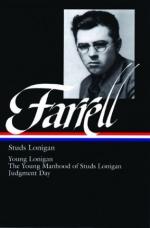|
This section contains 457 words (approx. 2 pages at 300 words per page) |

|
SOURCE: "Old Master," in The New Republic, Vol. 169, No. 25, December 22, 1973, p. 30.
In this review of Judith and Other Stories, Barnes remarks that Farrell's work continues to be dominated by grim and hopelessly limited characters.
The works of James T. Farrell cannot be discussed singly. His 22 novels, 14 collections of short stories, essays, literary criticism and poetry all center on his pessimistic determinism, conditioned by personal experiences and confirmed through intense observation of the human scene. He is indeed considered by some to be the literary heir of Upton Sinclair and Theodore Dreiser through his consistent depiction of urban decay, social corruption and individual despair.
In Studs Lonigan (1935) Farrell created an epochal document detailing as no one has surpassed, the environment of prejudice, inferiority, foamy sentiment and violence of lower working class Chicago. This was succeeded by the Danny O'Neill pentalogy, the Bernard Can trilogy (major but unevenly written novels...
|
This section contains 457 words (approx. 2 pages at 300 words per page) |

|


